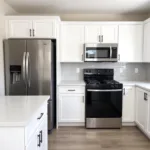Blue, a primary color, is often associated with tranquility and vastness. But what if you run out of blue paint or are experimenting with different mediums? What colors make the color blue? Surprisingly, you can’t mix other colors to create pure blue. It’s a primary color, meaning it stands alone. However, you can achieve various shades and tints of blue by mixing it with other colors. Let’s explore the fascinating world of blue and its many variations.
Exploring Shades of Blue: Mixing with Other Colors
While you can’t create blue from scratch, mixing it with other colors opens a world of possibilities, allowing you to achieve a broad spectrum of shades and tints. Adding white to blue creates lighter tints like sky blue or baby blue, perfect for creating a serene and airy atmosphere. Conversely, incorporating black into blue results in darker, richer shades like navy or midnight blue, ideal for adding depth and drama to a space.
Mixing Blue with Other Primaries
Combining blue with other primary colors—red and yellow—yields intriguing results. Mixing blue and red produces violet or purple, while blue and yellow create green. These secondary colors can be further adjusted by varying the proportions of each primary color. More blue in a blue-red mix will result in a blue-violet, while more red will create a red-violet. Similarly, more blue in a blue-yellow mix yields a blue-green, while more yellow creates a yellow-green.
Understanding the Science Behind Blue
Blue’s unique properties stem from its position on the electromagnetic spectrum. It has a shorter wavelength compared to colors like red or yellow, which affects how it is perceived by the human eye. This also influences how blue pigments interact with light and other colors when mixed.
How Light Affects Blue Pigments
When light hits a blue pigment, the pigment absorbs all colors except blue, which is reflected back. This is why we see the color blue. The specific shade of blue depends on the chemical composition of the pigment and the type of light illuminating it. Natural daylight will render a slightly different blue than artificial light.
Why Can’t We Make Blue?
The reason we can’t make blue lies in the fundamental nature of color. Primary colors are the building blocks of all other colors. They are pure hues that cannot be created by mixing other colors. Blue, along with red and yellow, is one of these fundamental hues.
The Role of Pigments and Light
Pigments are substances that absorb and reflect light at specific wavelengths. Blue pigments absorb all wavelengths of light except those in the blue spectrum. To create blue, we need a substance with this specific property, and we cannot replicate it by mixing pigments that absorb and reflect different wavelengths.
 Blue Pigment Interacting with Light
Blue Pigment Interacting with Light
what two colors make navy blue
Applying Blue in Interior Design
Blue is a versatile color in interior design, offering a wide range of moods and effects. From tranquil blues in bedrooms and bathrooms to vibrant blues in living rooms and kitchens, it’s a color that can transform any space.
“Blue offers a timeless elegance, whether you’re using a soft pastel or a deep, saturated hue,” says renowned color consultant, Amelia Hughes. “It can be both calming and invigorating, depending on the specific shade and how it’s used in a room.”
Conclusion
While you can’t create true blue by mixing other colors, understanding its properties and how it interacts with other pigments opens doors to a vast spectrum of shades and tints. From creating soothing pastels to dramatic darks, exploring the world of blue empowers you to create truly personalized and captivating spaces. So, embrace the versatility of blue and let it transform your world.
FAQ
- What are the primary colors? Red, yellow, and blue.
- Can I mix colors to get blue? No, blue is a primary color and cannot be made by mixing other colors.
- What colors make navy blue? Navy blue is achieved by mixing blue with black.
- What happens when you mix blue and yellow? Mixing blue and yellow creates green.
- What happens when you mix blue and red? Mixing blue and red creates violet or purple.
- How can I make lighter shades of blue? Add white to blue to create lighter shades.
- How can I make darker shades of blue? Add black to blue to create darker shades.
Situations Where These Questions Arise
These questions often come up in various situations, such as when an artist is experimenting with paint mixing, a homeowner is trying to match a specific shade of blue for a home improvement project, or a student is learning about color theory. Understanding how colors interact is crucial for various creative and practical applications.
Further Exploration
Explore more about color mixing and color theory on our website. We have articles on various color combinations, including what colors make blue.
Need help with your color choices? Contact us! Phone: 0373298888, Email: [email protected] or visit us at 86 Cầu Giấy, Hanoi. We have a 24/7 customer support team.

